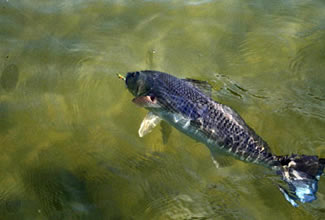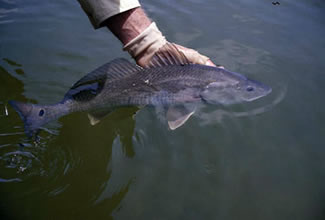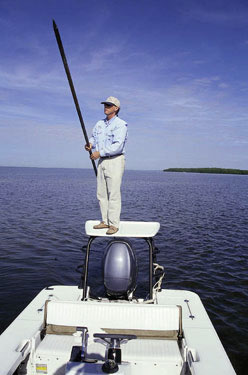May 16, 2011
By Norm Zeigler
Lessons for catching shallow-water reds in hard-pressured areas.
By Norm Zeigler
 A Pine Island Sound redfish takes the bait. |
Redfish as wary as bonefish? For some of us it's hard to believe, but there are days on Pine Island Sound when the reds are as spooky and lure-shy as any gamefish in the world.
On a recent trip with local guide Steve Bailey, we poled across a grassflat, making little noise. A redfish was moving diagonally from left to right, about 30 feet ahead of the boat at 11 o'clock. The fish had ignored one perfect cast and, because it was moving fast, I was inclined to let it swim away.
Advertisement
“Try him again,” Bailey said.
I made one false cast to gauge the distance and gain line speed in the wind, then put the fly six feet ahead of the fish, letting it settle for a couple of seconds. I stripped once and the fish turned; stripped again and it shot ahead to grab the fly. When I set the hook the water erupted and a split second later my reel was sizzling as the red took off.
Advertisement
Ten minutes later, the hefty 29-incher was alongside the boat.
Our final approach to that fish was memorably dramatic, but the most important strategy decisions we made occurred minutes before.
It's no secret that Pine Island Sound is one of the country's premier redfish destinations. But if you think it's because these fish are suckers, think again.
At the mouth of the Caloosahatchee River near Fort Myers, there's a great mix of habitat: grassflats, oyster bars, mangroves, creeks, cuts, potholes and bayous. Resident juvenile reds grow fat and happy on abundant forage. The adults—over 30 inches or so—become seasonal visitors, returning home from their wanderings in the Gulf of Mexico.
There was a time here when redfish movements and habits were fairly predictable, and it was pretty easy to catch them by stalking them on the flats. In recent years, however, Pine Island reds seem to have wised up to angling pressure.
Mike McComas of Lee Island Outfitters/Orvis in Fort Myers, ranks Pine Island reds among the most challenging quarry anywhere. “These fish are every bit as wary and as smart as bonefish in the Keys,” says McComas, who fished for 17 years in the Ten Thousand Islands before switching to the Sound. Some would say that's a bit of an exaggeration, but few would argue that where shallow-water fishing is concerned, the playing field has changed in favor of the fish.
Angling pressure and the growing number of boats on the water have fine-tuned the fish's noise awareness to hair-trigger sensitivity. These are spooky fish and if you want to catch them you had better learn how to be quiet.
Those of us who snorkel or scuba dive know how water magnifies sounds. It also increases the distance sound travels. If you doubt this, put your head underwater some time when a high-powered flats boat is rooster-tailing by a half-mile or more away.
Stealth is equally valid for mangroves. | |
And don't be lulled into complacency by the fact that fish lack external ears. Their internal hearing mechanisms are sensitive and finely tuned and their lateral lines register the tiniest water displacement.
The shallower the water the spookier the fish. This is especially evident in Pine Island Sound. But following a few basic procedures can greatly increase your chances of success.
The first is to stay as far as possible from likely redfish spots while running your boat at cruising speed. If you roar up to the edge of a flat on plane before shutting down you may see a series of wakes shooting away. Pull back the throttle to idle at least several hundred yards from the place you want to fish. Better still, shut down your running motor and use a trolling motor or pushpole to get to the spot. If there's wind, try to use it to your advantage and drift down on the fish.
Step softly in the boat at all times, taking care not to bang gear or drop even small items. Be especially careful with tackle boxes, bait buckets and hatches, which can cause an echo effect.
 Sight-fishers often first notice those copper pectorals or blue-tipped tail fin. |
There can be good fishing for reds on breezy days. But if there is chop on the water you should take into account that many fish have learned to recognize the sound of waves against a boat hull and will move away. Look for the fish farther out or, if possible, anchor the boat and wade.
Many of the stealth rules for flats fishing are equally valid for mangrove shorelines. Using your trolling motor may be convenient, but the vibration and prop whirring can alarm fish. Again, use a pushpole or dead drift if possible. And stay as far away from the shoreline as you can comfortably cast.
The Golden Rule is a good one to follow anytime you go looking for reds. Try to show as much respect and consideration for other anglers as you would like them to show you. There are few actions as thoughtless as roaring by other anglers close in and at high speed. Those of us who have been subjected to such actions by apparently brain-dead throttle jockeys know they can make the fish disappear faster than Penn and Teller. Slower is almost always better.
You can use slow speed zones to your advantage. Fishing these areas means that, except for the occasional scofflaw, you will not have to worry about motor noise spooking your quarry. Redfish in quiet waters are happier redfish. One area I like is the northern edge of the J.N. “Ding” Darling National Wildlife Refuge; much of the mangrove shoreline is off-limits to high-speed boat traffic. Inside the refuge are slow-speed and no-motor zones. If you like kayaking or wading, this is a good place to do it.
Mangrove shorelines skirting Pine Island Sound are most productive on the high end of an incoming tide and the beginning of the outgoing. Cast to pockets or skip a bait under overhanging branches. Also, listen for fish smashing bait hidden among the roots.
One of the best tactics for mangrove-shoreline reds is an old standby, a popp
ing cork with a shrimp below. The cork will often bring reds racing out of the underbrush to investigate. Popping plugs have the same effect, as do popper flies. Freelined pinfish and pilchards also work well.
On the flats, watch for tailers and put your shrimp, spoon, plug or fly about two feet in front of the fish's nose. In mid and late summer, in heavy grass, you may want to cast even closer so the fish will see your bait. But do not put a big plug or spoon too close or it can spook the fish when it lands. This is why unweighted flies are the choice of many anglers.
Thew premier time for flats fishing is the lower end of an incoming tide. | |
Some days you'll spot reds cruising the flats. Many grassflats here make for difficult wading because of silty, mucky bottom. But often the flats' outer edges, where they drop off into channels or potholes, are sandy and firm. Especially on an incoming tide it is often productive to wade or pole these sandy edges while watching for cruisers. Whether you are in the water or in a boat, do not get right on the edge. Stay back about the distance of a cast and watch for fish moving from either direction along the edge of the dropoff or moving out of deeper water up onto the flats.
The premier time for flats fishing is the lower end of a fast incoming tide, when reds move up into the shallows to chase baitfish or root in the bottom for shrimp, crabs and other feed. The best action usually occurs on days with the biggest tides.
Some good areas for flats action are the MacKeever Keys along lower Pine Island, Buck Key near the south end of Captiva, Foster Point on North Captiva and Panther Key near upper Pine Island.
Nearly the whole western shoreline of Pine Island offers outstanding mangrove fishing. Nautical charts are a help in finding areas that are easy to get into and out of. On the other side of the sound, some good spots are Horseshoe Bay (outside the entrance to Tarpon Bay), the Ladyfinger Lakes section of Tarpon Bay, Buck Key Channel, MacIntyre Creek and the Foster Point area. The last couple of hours of an incoming tide and the first hour of the outgoing are prime times to work the mangroves.
 Anglers who spend more time poling and less time powering frequently get more shots at skinny water redfish. |
When fishing the flats, it is always a good idea to cast to potholes. In deeper water, try working the edges of oyster bars. If fishing is in the doldrums, McComas recommends chumming the potholes with chopped ladyfish, or crushed threadfins or pinfish. “Sometimes when their tails are down, it's one way to get them happy,” he says.
Throughout the sound, boat anglers who do not have a flats boat, johnboat or another very shallow-draft craft need to be cautious and pick their spots when fishing a falling tide.
Pine Island Sound offers good redfish action throughout much of the year. Reds aren't bothered by the summer heat, and they tolerate cold snaps well (unlike snook, which become increasingly lethargic as the water temperature drops). Many anglers would say the premier month is October. This is the time for fast and furious action as huge schools of reds move through the sound feeding voraciously and preparing to spawn.
Even on its best days, however, the sound is a place where careful presentation can mean the difference between chasing fish and catching fish. Poling all day long—which is what Steve Bailey does to get on fish—might not be your game, but regardless of how you tackle the flats here, it pays to be stealthy.
SEALING THE DEAL
According to Robin Ramming, manager of the Bait Box on Sanibel, the deadliest bait for Pine Island reds is a baby blue crab from half-dollar to silver-dollar size. But these can be hard to obtain and also expensive. Pinfish, sardines and shrimp are all effective live baits. A chunk of dead ladyfish is a great dead bait.
The best artificials include gold spoons, plastic shrimp, green-and-white minnow plugs and soft-plastic jerkbaits or jig tails. Local outfitter Mike McComas also recommends a shrimp-tipped jig.
The most popular flies for Pine Island Sound reds include the usual suspects and a couple of less-common patterns. Steve Bailey, one of the area's top guides, puts chartreuse-and-white Clouser Minnows at the top of his list. He has developed his own, sparse-hair version with fluorescent orange eyes. Bailey ties his Clousers on a Mustad 3407 saltwater hook, size No 2.
Also high on the list are Deceivers, tied in yellow-and-white or chartreuse-and-white. Other favorite flies include crab patterns, snapping shrimp, cockroaches, copper spoon flies, chartreuse gurglers and my own pattern, Norm's Crystal Schminnow, a pearl-white shrimp-minnow tied with Crystal Chenille or Estaz.
McComas says one of his top producers is the Fugly, invented by him and the late Pete Billani. “It's a little bit like a blue crab,” McComas says. “The body's deer hair, it has some orange hackle coming out the back for claws, and bead-chain eyes.”
FS

